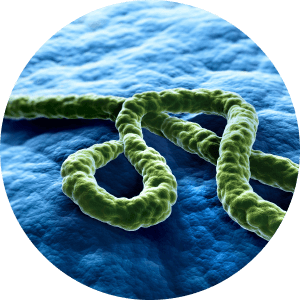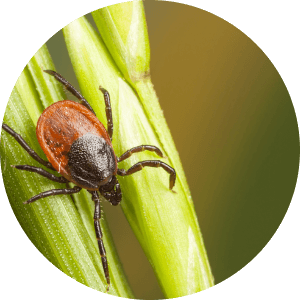Hemorrhagic Viral Vaccines Pipeline
Pipeline
Viral hemorrhagic fevers are virus-borne illnesses that affect multiple organ systems, often damaging the overall vascular system and impairing the body’s ability to regulate itself. These symptoms are often accompanied by bleeding. Many of these viruses cause severe, life-threatening disease.
Ebola Virus
Tick-borne Flavivirus
Crimean-Congo Hemorrhagic Fever Virus
Ebola Virus
We are using our ability to construct highly valid recombinant proteins to address Filoviruse with two approaches. The Company has developed and patented recombinant proteins from Ebola Zaire, Ebola Sudan, and Marburg virus.

These proteins are being developed into both individual vaccines and a multivalent Filovirus vaccine. Furthermore, under license from the Company, researchers at the University of Hawaii School of Medicine are working to develop a thermal-stable Ebola vaccine suitable for worldwide distribution with our a cold chain requirement. Non-human primate studies have confirmed the efficacy of our approach.
Tick-borne Flavivirus
The tick-borne flavivirus (TBFV) group includes a number of important human pathogens that result in serious neurological or hemorrhagic diseases. The TBFVs are considered to be emerging or re-emerging pathogens due to increases in the number of human infections, the expansion of their geographic distribution, and emergence of new viruses.

Additionally, the number of different viruses in the TBFV group poses challenges. There are two licensed Tick-borne encephalitis virus (TBEV) vaccines in Europe. These vaccines are based on the European strains of TBEV (TBEV-Eu), and while they provide some level of cross-neutralization, not all of the TBFV are covered. Furthermore, these vaccines are not licensed in the U.S. and are no longer available in Canada. The development of a multivalent vaccine that provides cross-protection against multiple pathogenic TBFVs would be of great value and is in line with the priorities of NIH/NIAID to develop multivalent and cross-protective technologies.
We have developed a candidate multivalent tick-borne flavivirus (TBFV) vaccine based on selected recombinant subunit envelope proteins from the TBFV group. We have demonstrated that two combinations of TBFV recombinant envelope subunit proteins provides protection against a diverse range of TBFV in a mouse challenge model. This vaccine provides broad cross-protection in proof-of-concept mouse challenge studies and the role of antibodies in protection has also been confirmed by serum passive transfer studies.
Crimean-Congo Hemorrhagic Fever Virus
Infectious agents that pose the greatest threat are those that are highly infectious, have high rates of mortality and lack any approved treatments. Crimean-Congo hemorrhagic fever virus (CCHFV), genus Nairovirus, family Bunyaviridae, is one such pathogen. CCHFV is a highly infectious virus, with mortality rates as high as 50%.

CCHFV’s natural geographic distribution continues to expand and whose highly pathogenic characteristics and potential to spread through various mechanisms make it a serious threat, whether through a natural outbreak or bioterrorism. CCHFV is classified as a biosafety level-4 (BSL-4) pathogen and has been recently reclassified as a Category A Priority Pathogen by NIH. This elevated level of priority for CCHFV is due to its highly infectious nature and recent reports of transmission by aerosol during the treatment of infected patients.
Hawaii Biotech is developing a CCHF vaccine utilizing our proprietary vaccine development platform. The goal of this program is to develop a safe vaccine demonstrating efficacious, protective immunity. Hawaii Biotech collaborates with the University of Texas Medical Branch to achieve our development objectives.
Ebola Virus
Ebola Virus
We are using our ability to construct highly valid recombinant proteins to address Filoviruse with two approaches. The Company has developed and patented recombinant proteins from Ebola Zaire, Ebola Sudan, and Marburg virus.

These proteins are being developed into both individual vaccines and a multivalent Filovirus vaccine. Furthermore, under license from the Company, researchers at the University of Hawaii School of Medicine are working to develop a thermal-stable Ebola vaccine suitable for worldwide distribution with our a cold chain requirement. Non-human primate studies have confirmed the efficacy of our approach.
Tick-borne Flavivirus
Tick-borne Flavivirus
The tick-borne flavivirus (TBFV) group includes a number of important human pathogens that result in serious neurological or hemorrhagic diseases. The TBFVs are considered to be emerging or re-emerging pathogens due to increases in the number of human infections, the expansion of their geographic distribution, and emergence of new viruses.

Additionally, the number of different viruses in the TBFV group poses challenges. There are two licensed Tick-borne encephalitis virus (TBEV) vaccines in Europe. These vaccines are based on the European strains of TBEV (TBEV-Eu), and while they provide some level of cross-neutralization, not all of the TBFV are covered. Furthermore, these vaccines are not licensed in the U.S. and are no longer available in Canada. The development of a multivalent vaccine that provides cross-protection against multiple pathogenic TBFVs would be of great value and is in line with the priorities of NIH/NIAID to develop multivalent and cross-protective technologies.
We have developed a candidate multivalent tick-borne flavivirus (TBFV) vaccine based on selected recombinant subunit envelope proteins from the TBFV group. We have demonstrated that two combinations of TBFV recombinant envelope subunit proteins provides protection against a diverse range of TBFV in a mouse challenge model. This vaccine provides broad cross-protection in proof-of-concept mouse challenge studies and the role of antibodies in protection has also been confirmed by serum passive transfer studies.
Crimean-Congo Hemorrhagic Fever Virus
Crimean-Congo Hemorrhagic Fever Virus
Infectious agents that pose the greatest threat are those that are highly infectious, have high rates of mortality and lack any approved treatments. Crimean-Congo hemorrhagic fever virus (CCHFV), genus Nairovirus, family Bunyaviridae, is one such pathogen. CCHFV is a highly infectious virus, with mortality rates as high as 50%.

CCHFV’s natural geographic distribution continues to expand and whose highly pathogenic characteristics and potential to spread through various mechanisms make it a serious threat, whether through a natural outbreak or bioterrorism. CCHFV is classified as a biosafety level-4 (BSL-4) pathogen and has been recently reclassified as a Category A Priority Pathogen by NIH. This elevated level of priority for CCHFV is due to its highly infectious nature and recent reports of transmission by aerosol during the treatment of infected patients.
Hawaii Biotech is developing a CCHF vaccine utilizing our proprietary vaccine development platform. The goal of this program is to develop a safe vaccine demonstrating efficacious, protective immunity. Hawaii Biotech collaborates with the University of Texas Medical Branch to achieve our development objectives.

